MoEngage Flows: How to Create Personalized Experiences for Customers
MoEngage’s customer journey orchestration suite, Flows, helps brands map customer journeys and build memorable customer experiences.
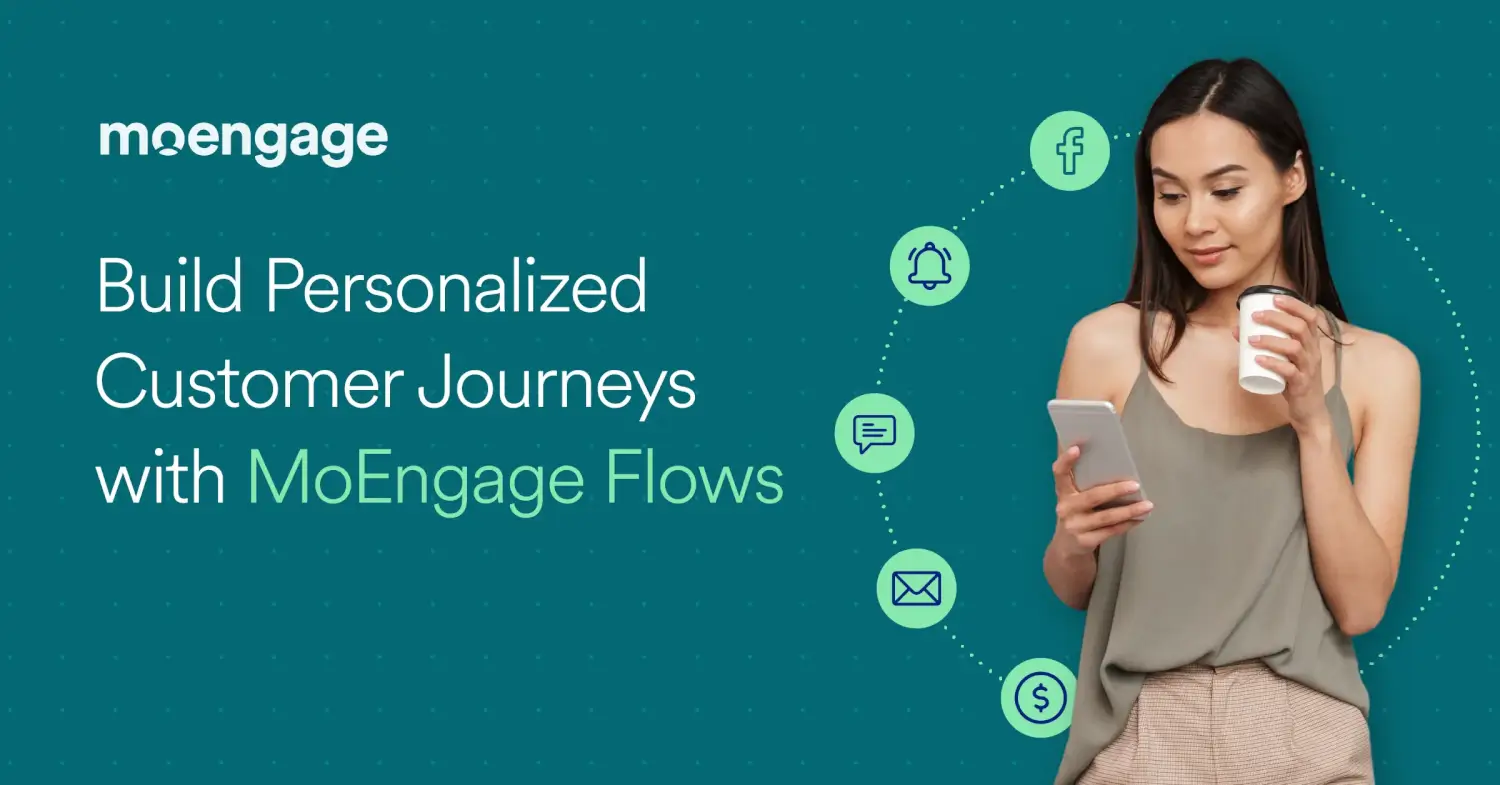
Reading Time: 10 minutes
Bonus Content For Building A Customer Journey
|
MoEngage’s recent Global Consumer Trends Report 2023 states that more than 50% of consumers engage with 3-5 channels before making a purchase.
To help brands tackle the challenges they face while building an efficient customer journey, MoEngage provides an enterprise-ready customer journey orchestration suite called Flows.
What Is a Customer Journey?
A customer journey is a collection of interactions between your customers and your brand or product.
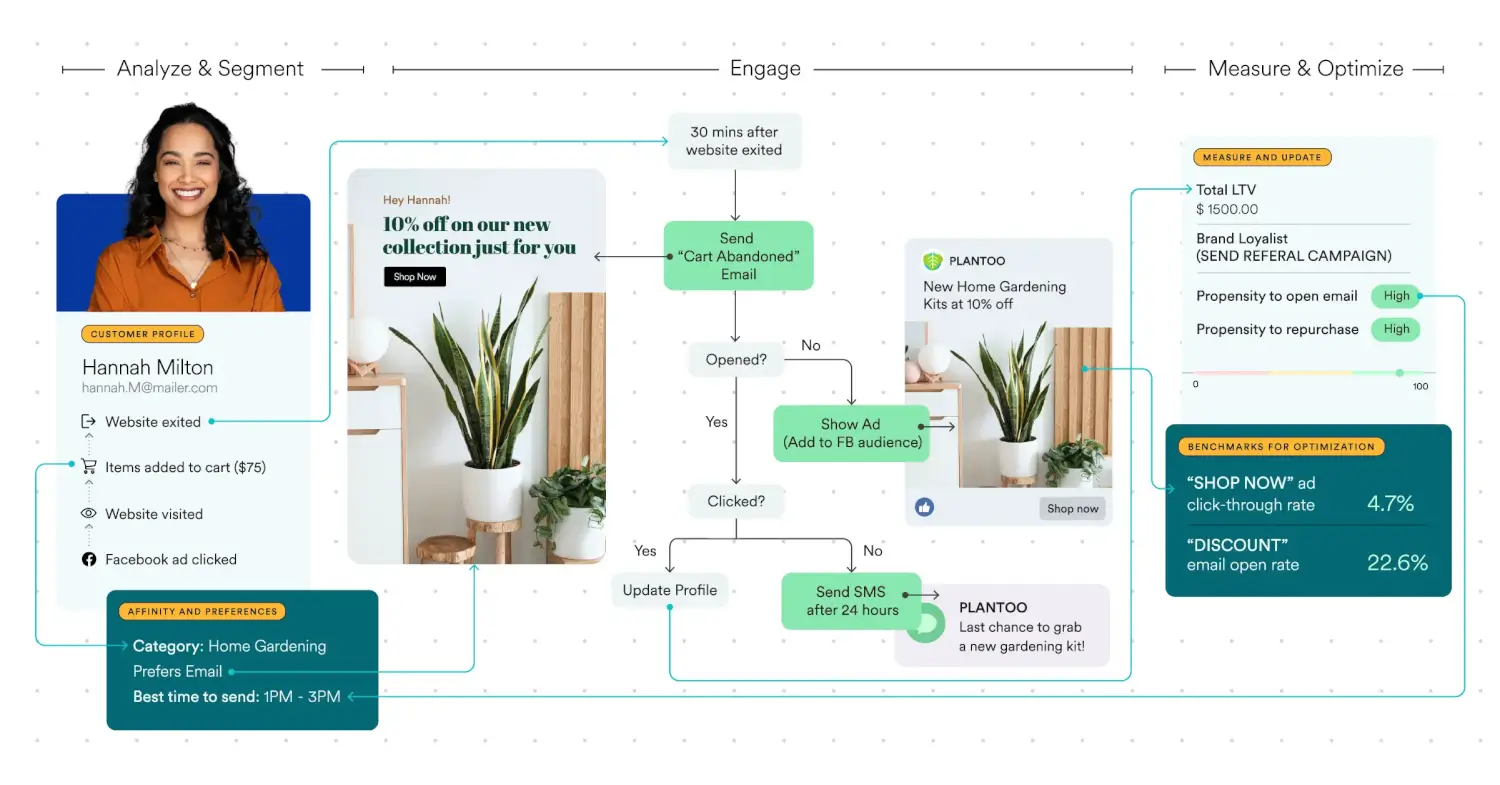
Customer journey paths include interactions your customers have over multiple channels, such as Emails, Push Notifications, Text Messages (SMS), In-app Messages, WhatsApp, and more.
A typical customer journey starts with social media or search engine interactions, either organically or via paid promotions. Few customer journeys also begin with a referral from an existing customer.
It is important to note that customer journeys do not end with a purchase or a conversion. Leading brands ensure that customer journeys extend post-purchase to ensure customers are retained for longer and come back to their products for repeat purchases.
What Are Common Customer Journey Challenges?
Modern consumer behavior has evolved over time, becoming increasingly erratic.
According to MoEngage’s recent Personalization Pulse Check Report, 12.46% of consumers switch brands when they receive irrelevant communication.
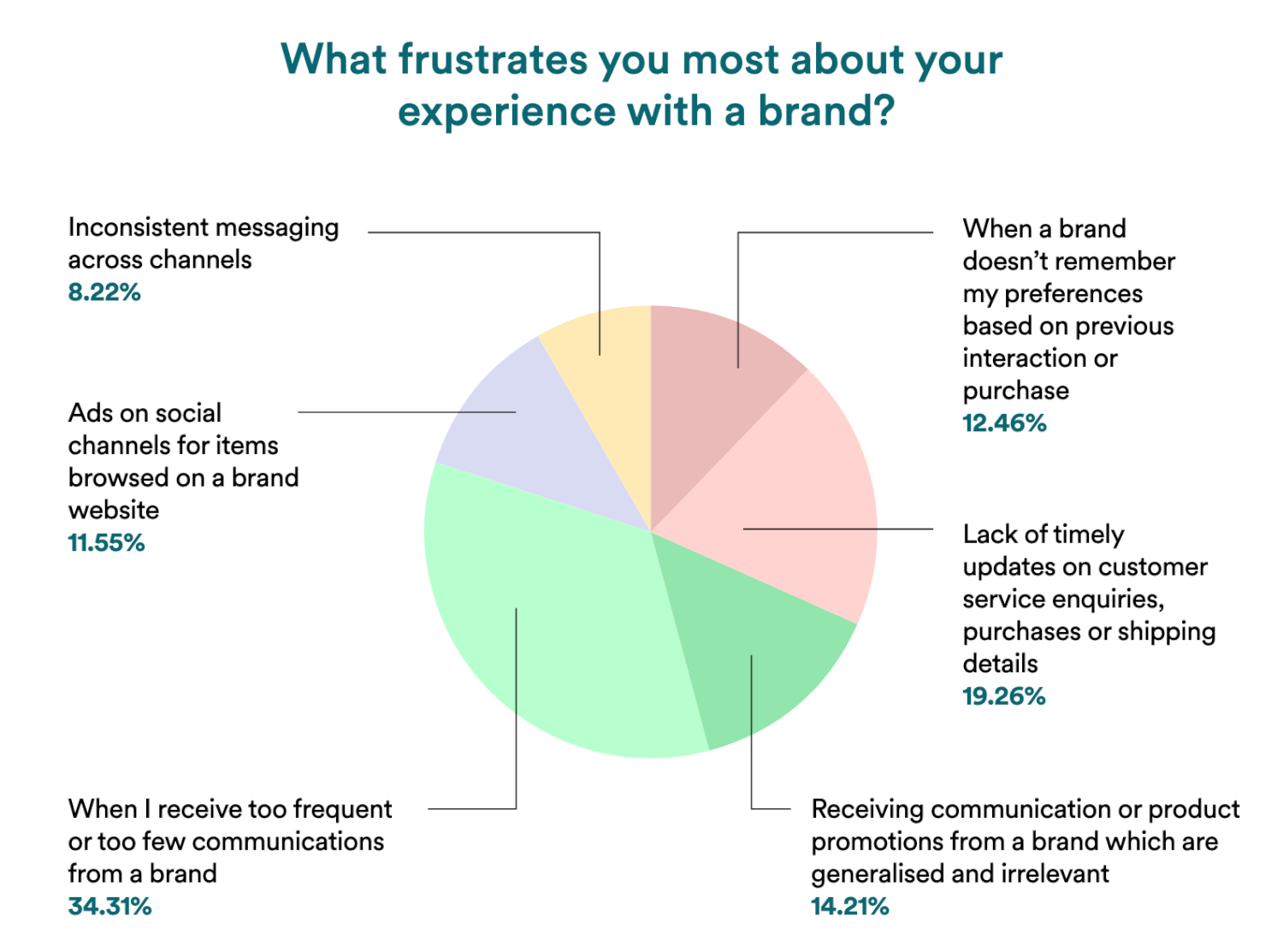
Here are the common challenges brands face when mapping customer journeys:
1. Lack of a holistic view and data of existing customer journeys
Data should always be at the heart of designing great customer journeys.
A lack of insights into customer journeys significantly threatens personalized customer experiences.
Without knowing how customers interact with your brand or product, brands make decisions to optimize experiences based on hunches and gut feelings, not data.
👉 Want to read more about insights-led engagement? Check out this ebook.
2. Increasing investment of time and resources into customer journey building
Mapping a customer journey and automating it should not be an activity that frustrates marketers and takes hours to execute.
Additionally, marketers and product managers should not have to rely on engineering teams to help them build customer journeys.
3. Complex mapping of multiple channels in customer journeys
Ensuring consistent messaging on multiple channels that are part of a single customer journey can become tedious as the number of channels increases.
On top of the multiple channels, as a brand, you send customers two types of communication – transactional and promotional, adding more nuances to designing a seamless customer journey.
4. Irrelevancy and a lack of personalization
Consumers expect personalized experiences at every interaction with a brand.
True personalization can be achieved with advanced segmentation based on customer attributes and behavior.
But without an automated journey builder and a strong analytics suite, brands miss out on personalization opportunities or spend too much time building their own solution.
Importance of Customer Journey Analytics and How to Capture Customer Journey Insights
Understanding the customer journey of your platform plays a key role in improving customer experience and optimizing it for maximum engagement.
Marketers and product managers need to know:
- Where are you losing most of your customers in the journey?
- How are customers navigating on your website or mobile app?
- Which customer cohorts are NOT converting? What actions are leading to low conversions?
- What steps in customer journeys are leading to the highest churn?
Learning from the leaders: How Empiricus increased customer journey conversions by 45%
Over a million Brazilians rely on Empiricus for investment consultations. With close to 2 million readers, Empiricus delivers investment recommendations to retail investors.
The team at Empiricus set up a customer journey to ensure seamless onboarding but noticed a huge drop-off when their customers opened the app for the first time.
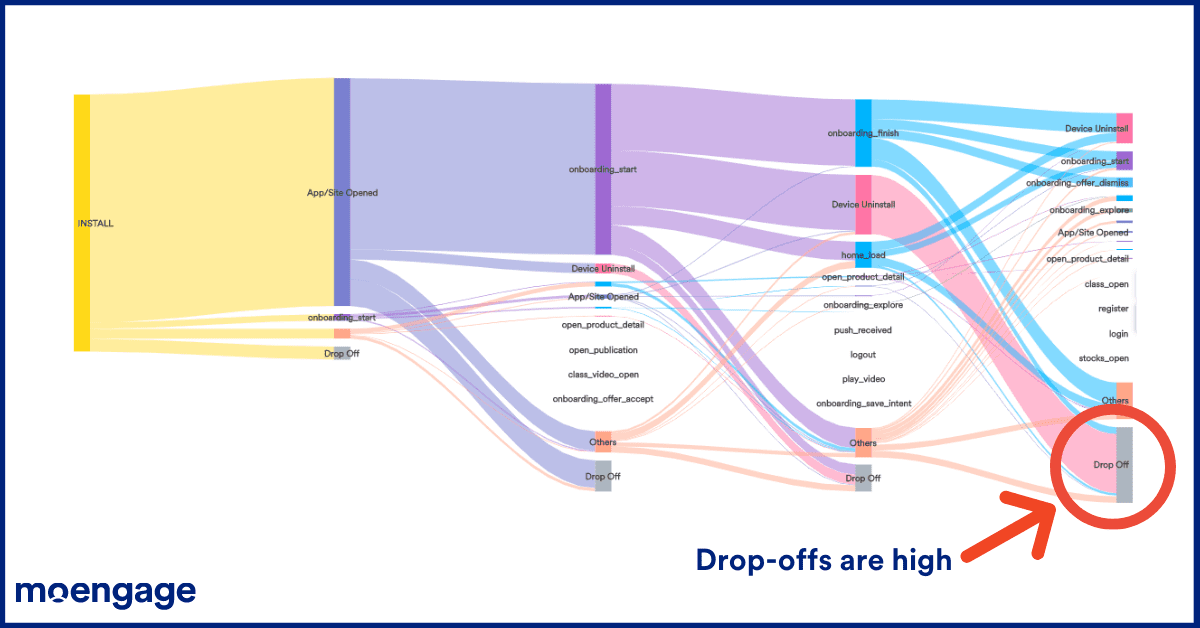
The team then used MoEngage’s User Path Analysis to gather insights into their onboarding journey in the mobile app and noticed a significant drop-off during the journey and decided to run an A/B test that involved changing the onboarding journey steps.
Thanks to this data-driven approach, Empiricus improved conversions by 45% and increased the number of app sessions by 20.3%!
You can read more about the success Empiricus saw with MoEngage here.
How Can MoEngage Flows Help Brands Build Personalized Customer Journeys?
MoEngage’s customer journey orchestration suite, Flows, houses multiple features that are invaluable to building personalized experiences and automating customer engagement efforts.
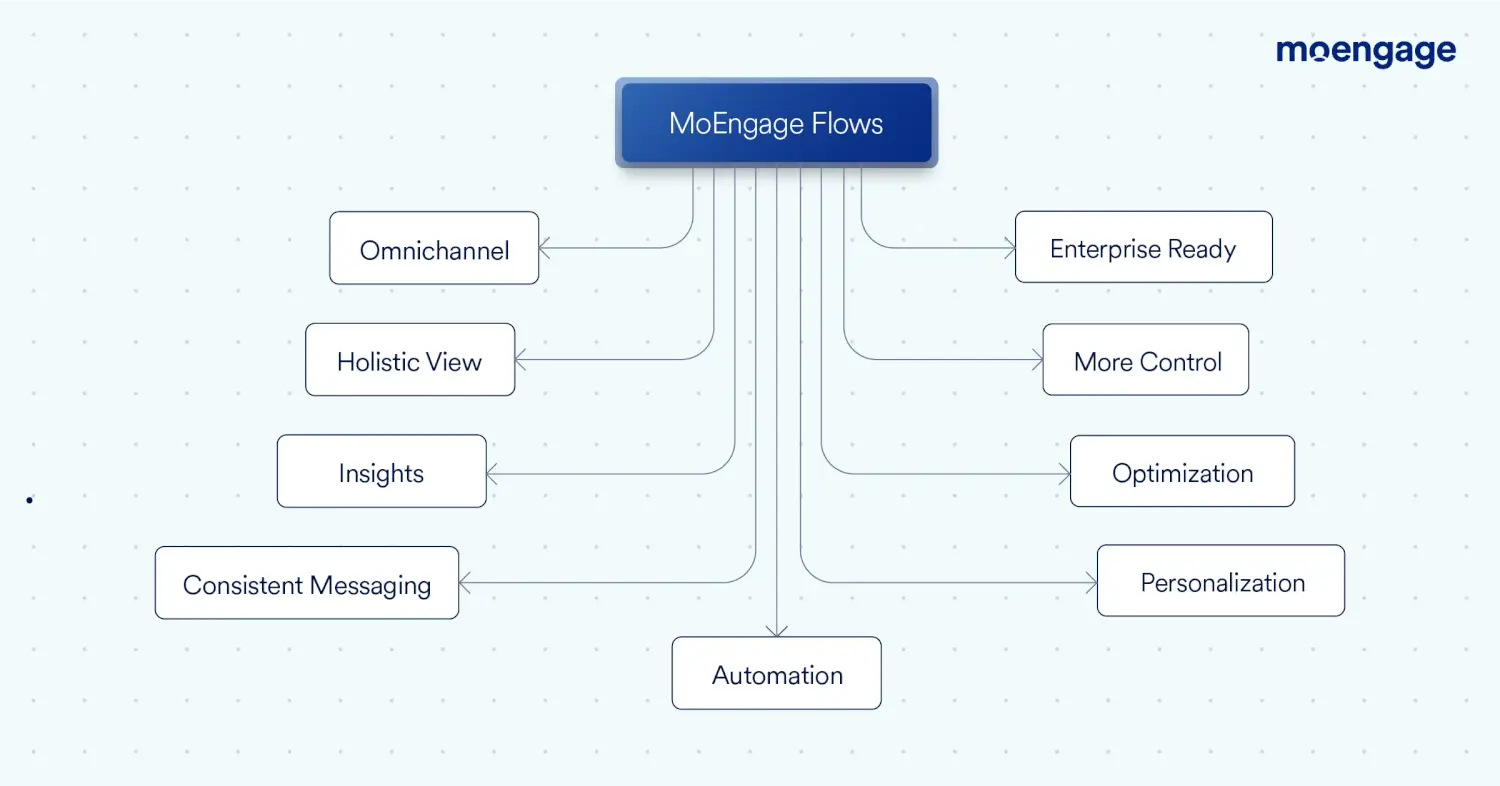
With Flows, brands can:
- Build complex customer journeys with multiple touchpoints
- Get a holistic view of customer journeys and their performance
- Gather insights on what’s working and what’s not and make data-driven decisions to improve customer experience
- Ensure seamless and consistent messaging across all communication channels
- Automatically send personalized communication based on customer attributes and behavior
- Navigate customers to the best performing and most optimum customer journey
- Optimize drop-offs in customer journeys
- Reduce investments in resources and time
- Visualise customer journeys and build them easily
- Control when customers move to the next stage of their journey
- Run A/B tests on journey paths, communication messages, channels, times, and customer segments
How have leading global brands benefited from MoEngage Flows?
- Kredivo Uses MoEngage Automated Flows to Influence Up To 40% Conversions
- Cocomelody Observes 20% Conversion Rate With MoEngage Flows
- Hallo Magenta Maximised Conversions by 30% Using MoEngage Push Notifications and Flows
Here’s a deep-dive into the multiple features that make MoEngage Flows the best customer journey builder:
No-code Visual Customer Journey Builder for Easy Customer Mapping
MoEngage’s no-code visual journey builder (Canvas) helps marketers and product managers remove dependencies on the engineering team to build customer journeys.
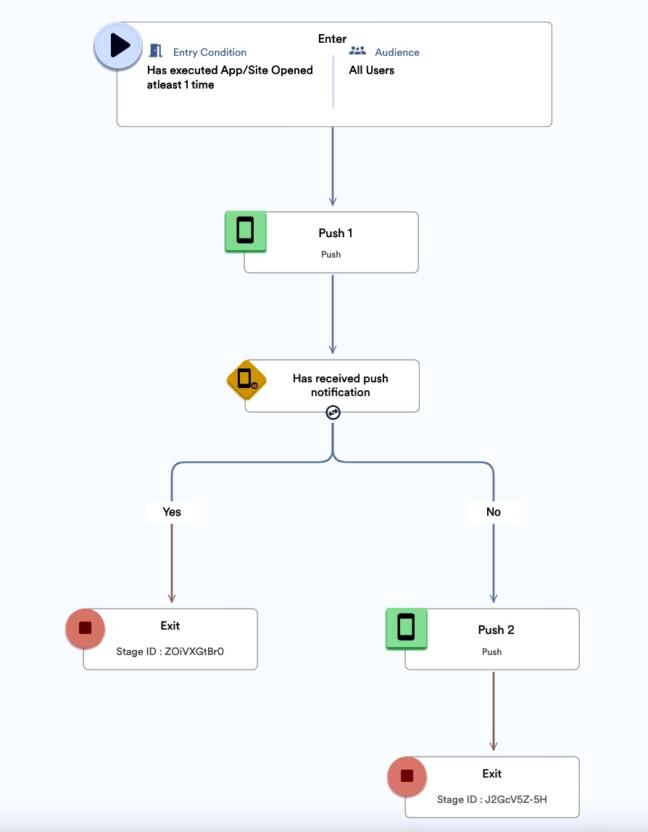
With a drag-and-drop builder, marketers, and product managers can get a holistic view of the customer journey and the
This information can be used to identify opportunities to optimize and increase the efficiency of customer journeys.
Marketers and product managers can also view the performance of a customer journey on this canvas in a single view.
Omnichannel Customer Journey Builder
Marketers and product managers can leverage MoEngage Flows to build customer journeys with multiple touchpoints.
Here is a list of all the communication channels available:
- Web and Mobile Push Notifications
- Text Messages (SMS)
- Mobile in-app Messages
- Website Banners
- Facebook Ads
- Google Ads
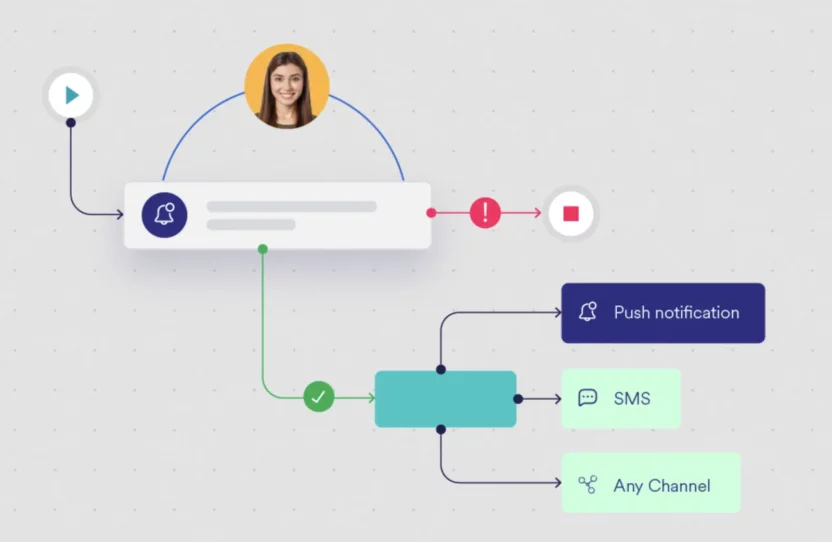
Using MoEngage Flows, marketers and product managers can also build and optimize a customer journey with communication sent over one channel only.
Wait For/Till and Go To: Get More Control Over Customer Journeys
With MoEngage’s Wait For/Till feature, marketers and product managers have better control over when their customers reach a new Flow Stage. This helps in sending the right communication at the perfect time.
How does Wait For/Till help brands?
- Be relevant. Marketers and product managers can add context and relevancy to their omnichannel campaigns.
- Get more control. Wait For/Till ensures marketers and product managers have higher control over when customers receive a particular communication.
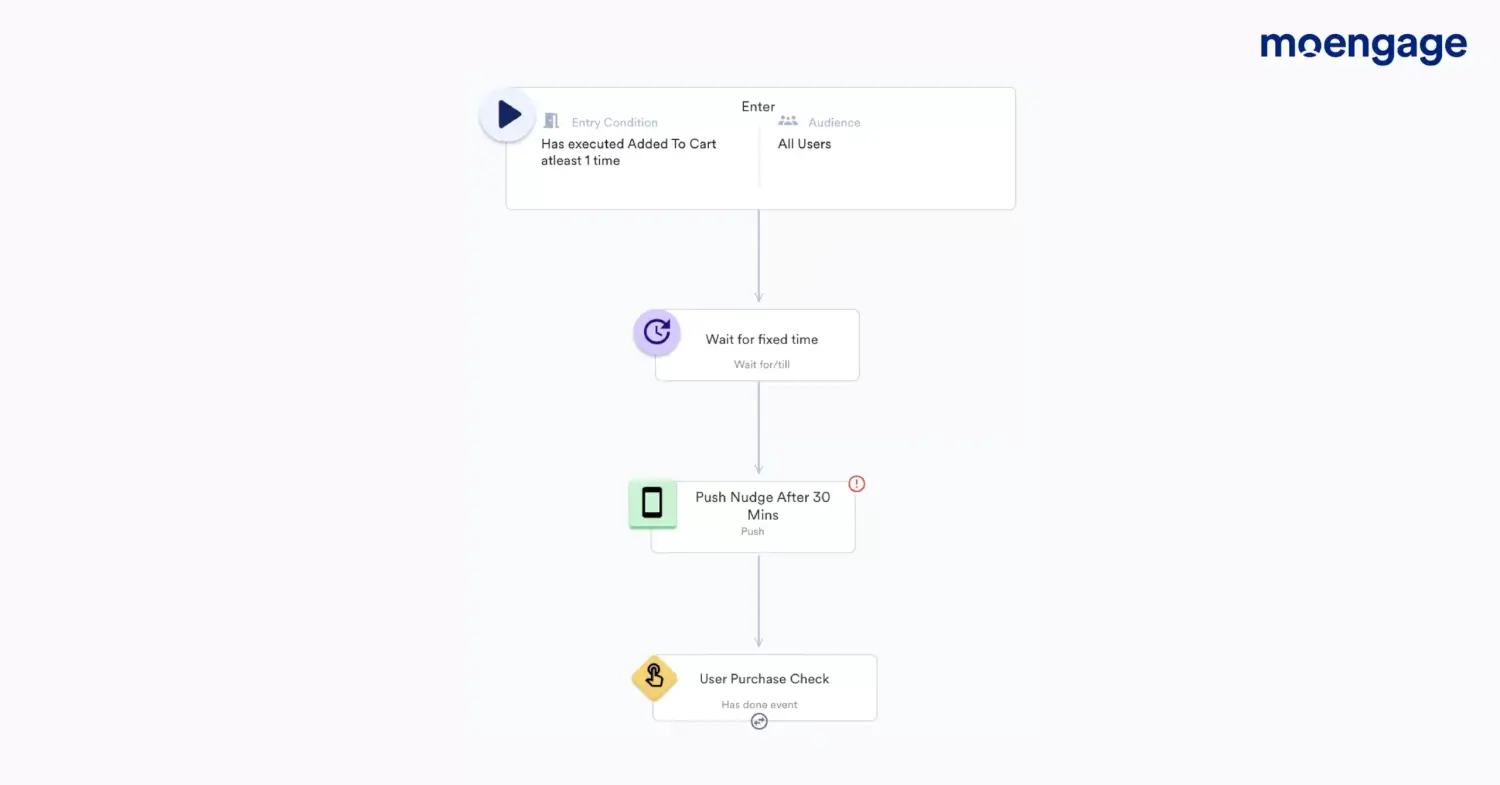
Common use-cases of MoEngage’s Wait For/Till
|
MoEngage’s Go To feature helps marketers and product managers send customers to any existing Flow Stage, avoiding duplication of stages and making the customer journey very complex.
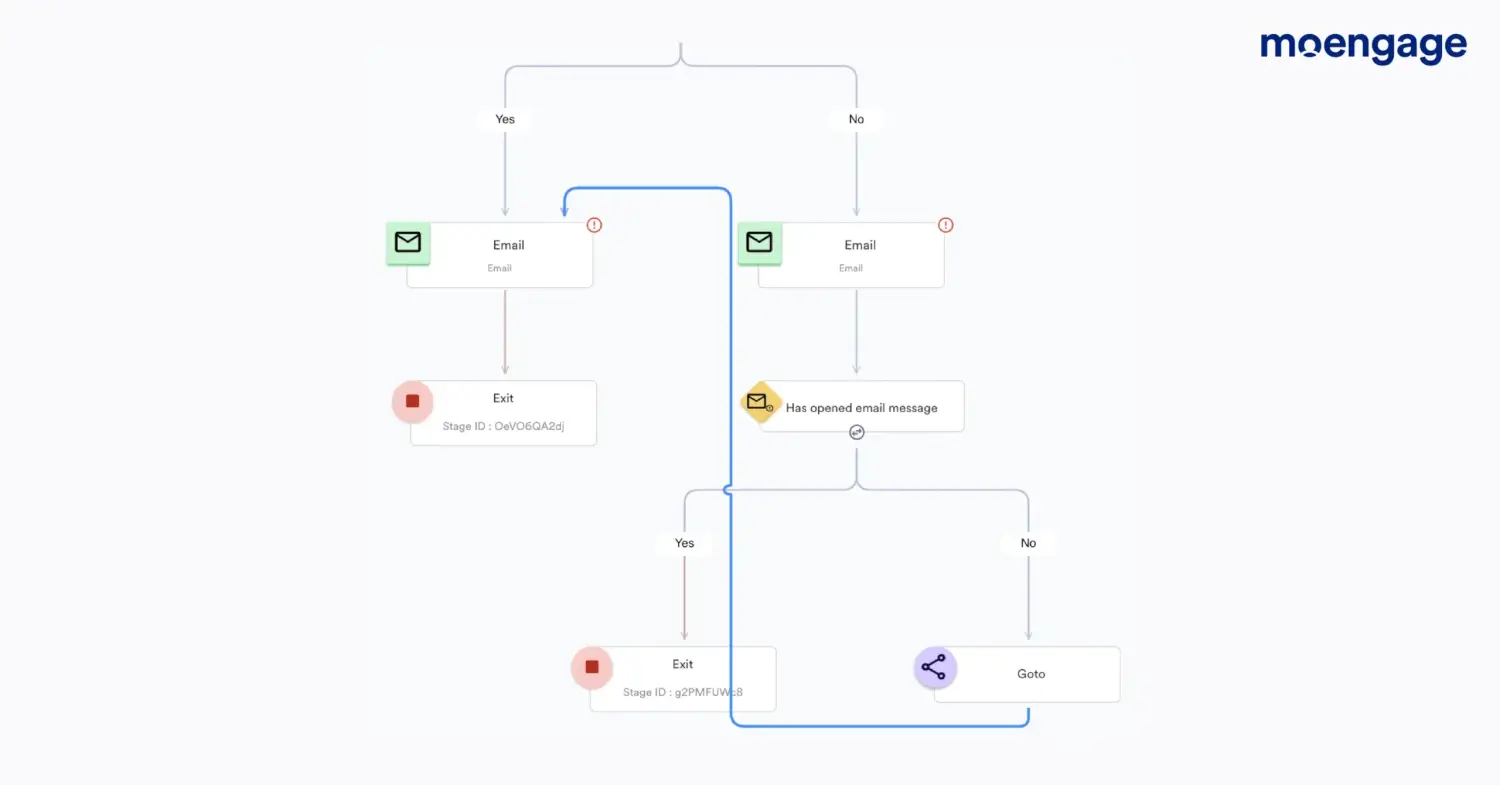
A/B Split and Conditional Split: Run Customer Journey Experiments With Ease
With MoEngage’s A/B Split, marketers and product managers can run experiments on multiple test cases on the fly.
Conditional Split helps marketers and product managers take decisions based on customer attributes and behavior.
How do A/B Split and Conditional Split help brands?
- Identify what’s working and what’s not. A/B Split will let marketers and product managers know what messaging and which communication channels are performing better than others.
- Send personalized communication. Marketers and product managers can check whether a customer has taken a particular action and send them contextual communication based on whether the action was done or not.
- Optimize customer journeys. MoEngage’s Conditional Split will automatically change the customer journey path based on a customer’s previous actions, such as email opens or push notification clicks.
- Experiment quickly. Marketers and product managers can quickly experiment with channels, messaging, and frequency of messages across multiple customer journey paths.
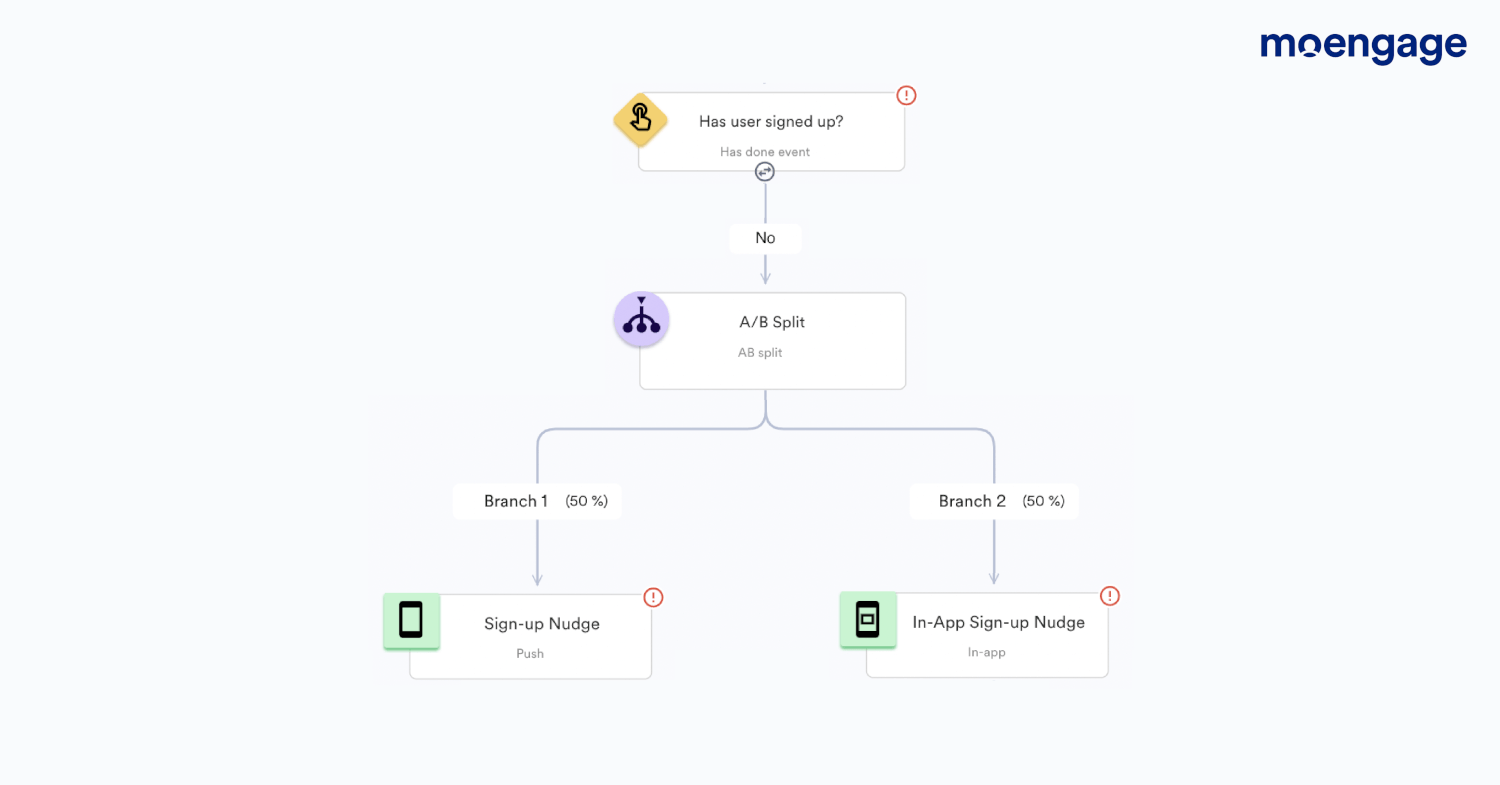
Common use-cases of MoEngage’s A/B Split and Conditional Split
|
Intelligent Path Optimizer For AI-driven Optimization
MoEngage’s Intelligent Path Optimzer feature automatically moves customers in a journey to the winning branch of A/B or Multivariate tests.
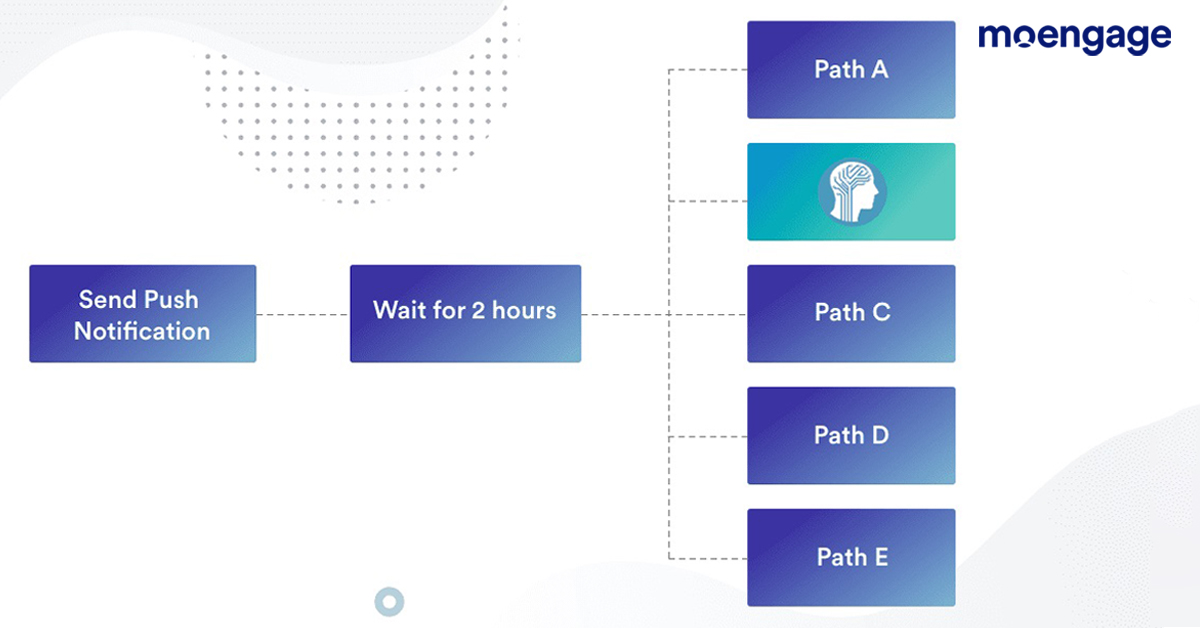
How does Intelligent Path Optimizer help brands?
- Reduce manual efforts. Automatically test which messaging works best for a set of customers.
- Optimization with Artificial Intelligence. Marketers and product managers can test which channel mix and path is working best, and use AI to optimize for the best path in a customer journey.
- Automate customer distribution. Intelligent Path Optimizer will automatically adjust customer distribution towards the best-performing customer journey path.
Common use-cases of MoEngage’s Intelligent Path Optimizer
|
Next Best Action: Eliminate Guesswork When Building Customer Journeys
Next Best Action (NBA) in Flows is an industry-first feature from MoEngage.
Combining our insights-led engagement suite with Sherpa’s capabilities, NBA helps marketers and product managers engage with customers seamlessly.
How does Next Best Action work?
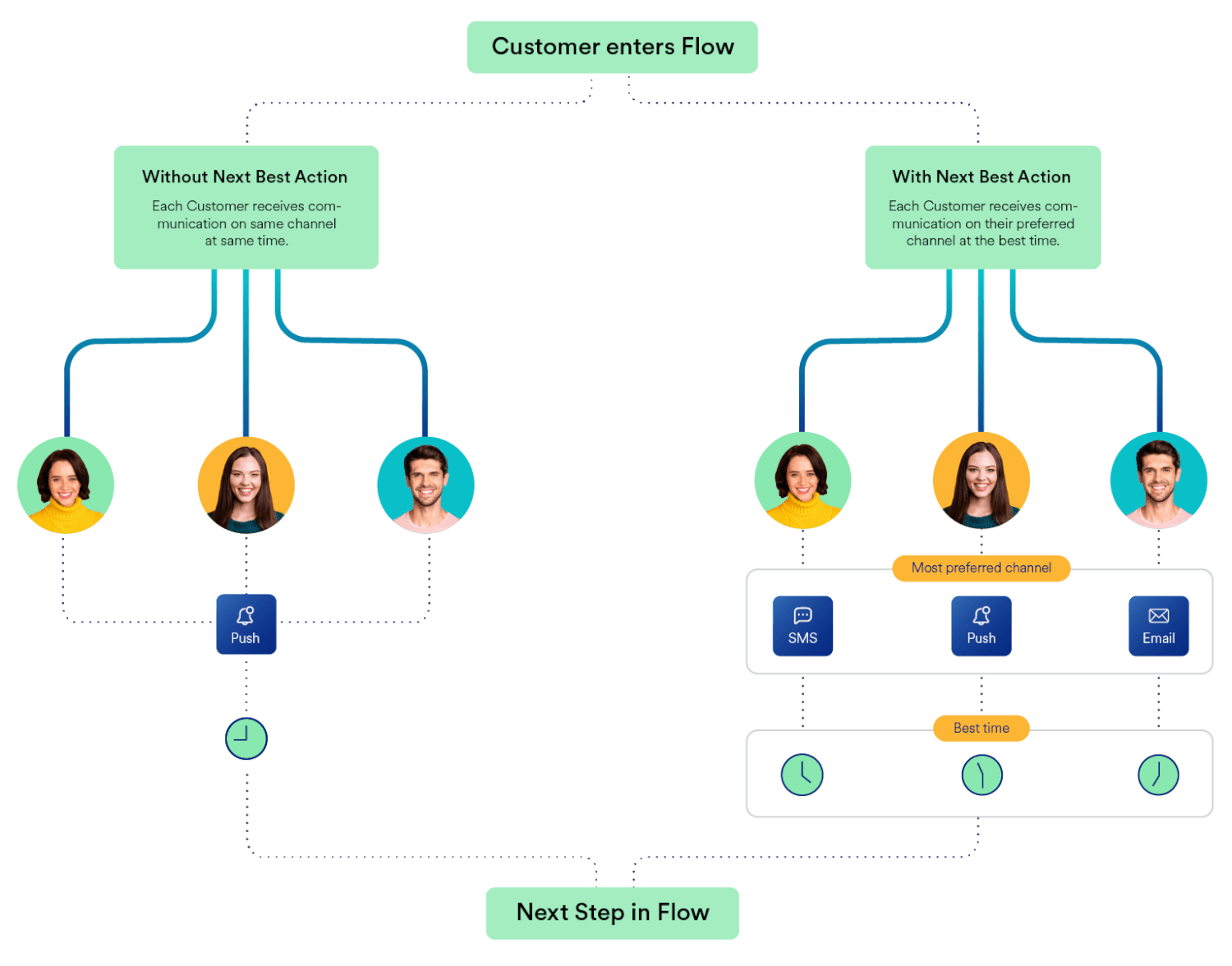
NBA helps marketers and product managers send omnichannel campaigns to each customer segment on their most preferred channels.
It also helps determine the best time to maximize conversions, reducing overall marketing spending.
For every customer’s journey, NBA intelligently analyzes engagement behavior and draws insights. Based on these insights, NBA decides the best channel and time to send a message to a customer.
How does Next Best Action help brands?
- Avoid guesswork. No more “what ifs”! Know which channel and time work best for your customers.
- Reduce manual efforts. No more lengthy durations deciding how to engage with customers creating complex customer journeys. Using Sherpa AI predictive analytics, you can now optimize the best path for your customers’ buying journey!
- Maximize engagement. Using Next Best Action, marketers and product managers can maximize their campaign engagement without adding channels that see low conversion.
Common use-cases of MoEngage’s Next Best Action
|
Multiple Conversion Goals and Revenue Tracking: Customer Journey Insights
With MoEngage’s Multiple Conversion Goals feature, marketers and product managers can keep a check on the intermediate and final goals of a customer journey.
This ensures that customers that have already proceeded to the latter stages of their journey are not spammed by irrelevant communication.
Common use-cases of MoEngage’s Multiple Conversion Goals
A marketer at an E-commerce platform can analyze customers who have added items to their carts or wishlists and send them offers instead of customers who have already purchased an item.
A product manager of a Banking mobile app can remove customers from their onboarding journey as soon as the new customers complete their KYC Process.
Marketers and product managers can leverage MoEngage’s Revenue Tracking feature to gain better visibility on the monetary impact of their campaigns in the customer journey.
Dynamic Personalization with Product and Event Attributes: Linked Conditions
With MoEngage’s Linked Conditions capability, brands can now engage and dynamically personalize campaigns for high-intent customers more effectively. For example, you can use any primary event’s attributes to define better conditions for your secondary event. You can also personalize conditions by comparing customer attributes with event attributes.
Here’s how this might look:
Imagine a customer receiving an irrelevant message like “Credit card payment of $340 is due on August 24. Pay via your app today to avoid late charges,” even if they have already paid their credit card bill. This will create a lack of trust in your brand and increase frustration for the customer.
With Linked Conditions, you can instead connect two events together so that personalization occurs more dynamically. This means that you can link events such as:
- Whether the customer has a bill-generated event for them
- Whether the customer has a paid bill event for them
Then, you can compare the bill-generated event with the payment made or the paid bill event by dynamically comparing the two events. To learn more, click here.
Conclusion: MoEngage Is the Right Solution for Your Customer Journey Mapping and Building Challenges
Consumer expectations are higher than ever.
The top expectations consumers have from brands are to deliver excellent service and relevant communication. And any brand that fails to deliver a seamless customer experience ends us losing customers immediately!
Every customer expects a personalized customer journey.
So, where does that leave brands?
While there are solutions that can help marketers and product managers map and build customer journeys, MoEngage’s customer journey suite, Flows, stands out.
If you’re looking for a customer journey builder that helps connect multiple channels together, run A/B tests, gather insights, and save time and resources, request a demo of MoEngage Flows now!














